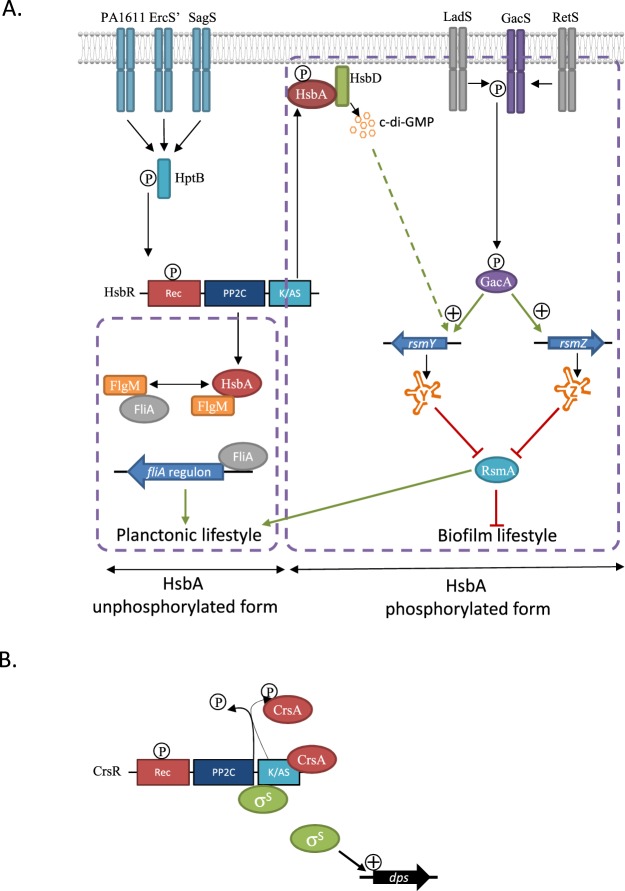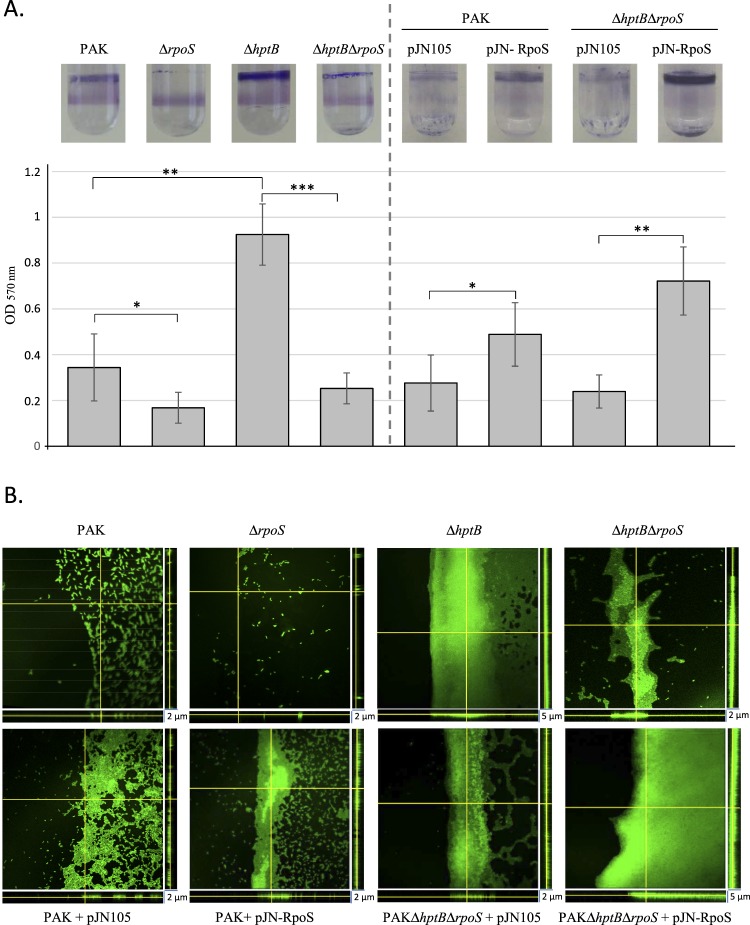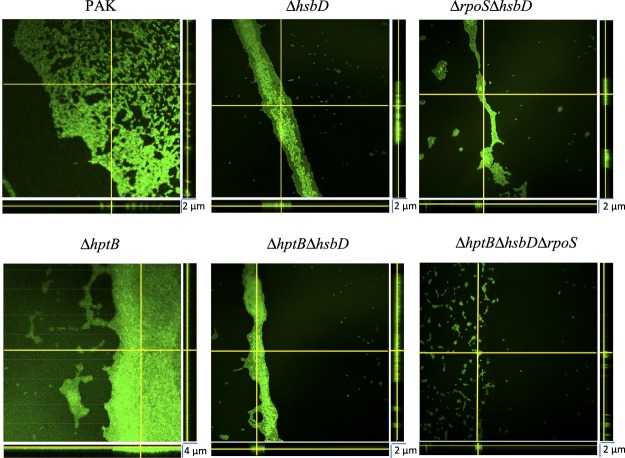Abstract
Biofilm formation is a complex process resulting from the action of imbricated pathways in response to environmental cues. In this study, we showed that biofilm biogenesis in the opportunistic pathogen Pseudomonas aeruginosa depends on the availability of RpoS, the sigma factor regulating the general stress response in bacteria. Moreover, it was demonstrated that RpoS is post-translationally regulated by the HsbR-HsbA partner switching system as has been demonstrated for its CrsR-CrsA homolog in Shewanella oneidensis. Finally, it was established that HsbA, the anti-sigma factor antagonist, has a pivotal role depending on its phosphorylation state since it binds HsbR, the response regulator, when phosphorylated and FlgM, the anti-sigma factor of FliA, when non-phosphorylated. The phosphorylation state of HsbA thus drives the switch between the sessile and planktonic way of life of P. aeruginosa by driving the release or the sequestration of one or the other of these two sigma factors.
Subject terms: Bacterial genetics, Biofilms
Introduction
The study of biofilm biogenesis, composition, and behaviour is of crucial importance in many fields of general interest. Indeed, biofilms are involved in various processes with positive or negative effects. In an environmental context, biofilms can function in clean up processes of soil and water by transforming or degrading toxic compounds as described for bioremediation of Cr(VI) or Ars(III)1,2. However, sessile communities are also responsible for microbial-induced corrosion and fouling, presenting economic impacts for industry and in the last case, biofilm formation has to be hampered3. When biotic surfaces support biofilms, the association can be either beneficial, as it is for plants that can be protected against soil-borne pathogens or deleterious as it is for humans during chronic infections4,5. The impact of biofilms is global; i.e., it is important to understand the various regulatory routes that lead to their biogenesis and dispersion. In Escherichia coli, biofilm formation depends on various regulators and among them RpoS. It is the general stress response sigma factor, which allows bacterial survival and adaptation under stressful conditions6. In Pseudomonas aeruginosa PAO1, the dependence of biofilm formation on RpoS is not as clear7. Biofilms formed in flow cell chambers are thicker in the absence of RpoS whereas under chlorine stress, the increase in RpoS is correlated to an increase in biofilm amount8,9.
P. aeruginosa is an opportunistic pathogenic bacterium that adopts a sessile lifestyle during chronic infections or a planktonic lifestyle for acute infections. Multiple components have been reported in the literature to regulate motility or biofilm formation in Pseudomonas species, including transcriptional regulators, sigma/anti-sigma factors10–12, and small RNAs13. However, the signals perceived by these different pathways and the interconnections and overlaps between these layers of regulation are still unclear. One of the central two-component signal-transduction systems (TCSs) that is critical to the switch between bacterial sessile and motile lifestyle is the TCS GacS/GacA14,15 (Fig. 1A). GacS is an unorthodox histidine kinase (HK) and GacA is its associated response regulator (RR) that functions as a transcriptional regulator which directly and positively controls expression of RsmY and RsmZ, two small non-coding RNAs16. RsmY and RsmZ are proposed to be key players in controlling the switch between planktonic and biofilm lifestyles and high expression of the rsm gene leads to massive biofilm formation. These two sRNAs out-titer the RNA-binding RsmA translational repressor and release RsmA from its mRNA targets. Titration of RsmA leads to production of biofilm determinants and repression of genes associated with planktonic lifestyle-like flagellar genes17,18. The action of the GacS/GacA TCS on these two bacterial small RNAs (sRNAs) is fine-tuned by the sophisticated regulatory network of the TCS, including the RetS, LadS, and Hybrid HK and the HptB pathway19,20 (Fig. 1A). The HptB pathway is a multikinase-network in which the three Hybrid HKs PA1611, SagS, and ErcS’ collaborate to detect and integrate signals which lead to the transphosphorylation of the HsbR RR through the HptB protein21–24. HsbR contains a receiver domain (Rec), which is the target of the HptB protein, a phosphatase (PP2C) domain, and kinase/anti-sigma factor domain (Figs 1 and S1). HsbR and HsbA, the anti-sigma factor antagonist, form a partner switching system in which HsbR controls the HsbA phosphorylation state through its enzymatic domains19,25. A partner switching system implies several partners (e.g., anti-sigma factor, anti-sigma factor antagonist, and sigma factor), which constitute an interaction network that is dependent on the phosphorylation state of the anti-sigma factor antagonist. Thus, the phosphorylation state of HsbA triggers switches between biofilm formation and planktonic lifestyle. Briefly, activation of the HsbR phosphatase domain de-phosphorylates HsbA, and in the presence of this form, HsbA binds the anti-sigma factor FlgM. Consequently, FlgM releases the sigma factor FliA (also named sigma factor26), which in return induces flagellar gene expression and promotes the planktonic lifestyle21,25. By contrast, when the HsbA protein is phosphorylated by the HsbR kinase domain, HsbA binds to the HsbD diguanylate cyclase, promoting its localisation at cell poles and activating biofilm formation by induction of the rsmY gene27 (Fig. 1A).
Figure 1.
Model for the HtpB/HsbRAD, GacS/GacA/Rsm and CrsRA/RpoS signaling network. (A) Unphosphorylated form of HsbR triggers HsbA phosphorylation through its kinase/Anti-σ factor domain (A/KS). Once phosphorylated HsbA binds HsbD diguanylate cyclase and triggers c-di-GMP production which is rsmY inducer27. RsmY production induces biofilm formation by sequestering/inhibiting RsmA. Phosphorylated form of HsbR triggers HsbA dephosphorylation through its phosphatase domain (PP2C). Once dephosphorylated HsbA binds FlgM anti-σ factor and trigger swimming motility thought FliA σ-factor25. HsbA dephosphorylation shutdown biofilm formation by inhibiting HsbD c-di-GMP production. Dashed lines suggest a probable indirect regulation. (B) Phosphorylation of CsrA by the CsrR kinase/Anti-σ factor domain (A/KS) leads to dissociation of the CsrA-CsrR complex and a subsequent stable sequestration of RpoS sigma factor by CsrR. Dephosphorylation of CsrA by the CsrR phosphatase domain (PP2C) leads to formation of the CsrA-CsrR complex and a release of the RpoS sigma factor.
Recently, a novel partner switching system, CrsR-CrsA, was been discovered in the aquatic bacterium Shewanella oneidensis28. The CrsR-CrsA system is responsible for the post-translational regulation of RpoS (also called sigma S factor) and the specific interaction between CrsR and RpoS was clearly established in vitro and in vivo26,29 (Fig. 1B). CrsR contains the anti-sigma factor domain that, during the exponential phase of bacterial growth, sequesters RpoS and phosphorylates CrsA, the anti-sigma factor antagonist. When cells reach stationary phase, a signal arises and the phosphatase domain of CrsR dephosphorylates CrsA, which in turn binds the anti-sigma factor domain of CrsR. Under these conditions, RpoS is released and can bind the RNA polymerase to express its regulon, inducing the general stress response (Figs 1B and S1). According to bioinformatics analysis, CrsR-CrsA homologs are widespread in the phylum of proteobacteria, among which the HsbR-HsbA system of P. aeruginosa is included28,29.
The aim of this study was to analyse whether in P. aeruginosa, the HsbR-HsbA partner switch is involved in the post-translational regulation of RpoS, as is the case for the CrsR-CrsA partner switch present in S. oneidensis. Moreover, the role of RpoS in the switch between sessile and planktonic lifestyles of P. aeruginosa is questioned.
Results
HsbR and CrsR interact with RpoS from S. oneidensis and P. aeruginosa
HsbR exhibited 25.5% identity and 48.5% similarity with CrsR and shared the same domain organisation; i.e., receiver, phosphatase, and kinase/anti-sigma factor (GHKL ATPase/kinase superfamily) domains (Fig. S1). Moreover, HsbA, the anti-sigma factor antagonist that is phosphorylated by HsbR, possessed 31% and 43% identity and similarity, respectively, with CrsA, the anti-sigma factor antagonist involved with CrsR (Fig. S1). Thus far, the third domain of HsbR is considered for its kinase activity towards HsbA and its ability to bind phosphorylated HsbA but with no sigma factor as a direct target. HsbA is described to be part of a partner-switch involving the anti-sigma factor FlgM, the sigma factor FliA (sigma factor26), and the kinase HsbR. Because of the homologies between CrsR and HsbR, and CrsA and HsbA, we hypothesised that HsbR and HsbA constitute a partner-switching system that regulates RpoS in P. aeruginosa. By bacterial two hybrid experiments, we observed that the anti-sigma factor domains (D3 domains) of CrsR and HsbR were able to form homodimers, as shown in previous studies20,26 and more interestingly, they can also interact with one another (Figs 2A and S2 [controls]). This could indicate that the two D3 domains are closely related in structure and function and may play a similar role. Furthermore, we observed that each D3 domain could interact with both anti-sigma factor antagonists (Fig. 2A). It was previously established that CrsRD3 interacts specifically with RpoS in S. oneidensis26. Thus, we tested whether HsbRD3 was also able to bind RpoS of S. oneidensis (RpoSSO). It appears that this last recognised the anti-sigma factor domain D3 of CrsR as expected but also, at a lower level, that of HsbR (Figs 2B and S2 [controls]). This result indicates that the two systems could be functional homologs. To investigate this, we tested, using the same approach, if RpoS from P. aeruginosa could interact with the D3 domain of HsbR and CrsR. Clearly, HsbRD3 interacted with RpoS from P. aeruginosa as well as with CrsR. This is an important finding since it indicates that RpoS could be the target of the HsbR-HsbA partner-switch and if true, HsbR-HsbA post-translationally regulates RpoS and therefore the general stress response in P. aeruginosa. More importantly, since HsbR and HsbA are involved in biofilm biogenesis through sRNA regulation, the connection between RpoS and the HsbR-HsbA partner-switch suggests that RpoS is involved in biofilm biogenesis in this organism.
Figure 2.
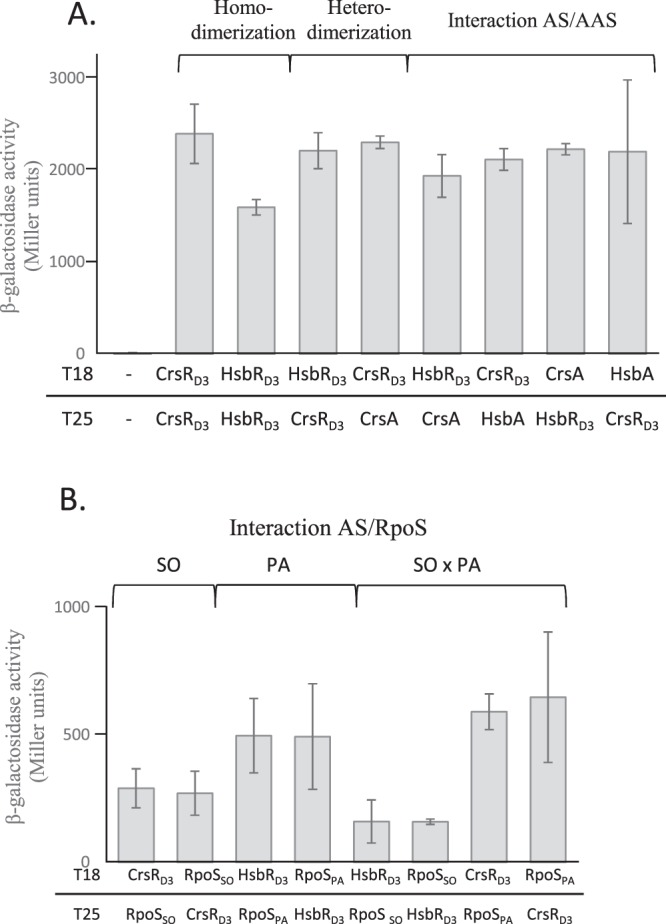
In vivo interaction by a two-hybrid assay between the partner-switch proteins of P. aeruginosa and S. oneidensis. (A) Homo-, hetero-dimerization and interaction between the anti-sigma factor domains of CrsR and HsbR and the anti-sigma factor antagonists CrsA and HsbA. (B) Interaction between the anti-sigma factor domains of CrsR and HsbR and RpoS from P. aeruginosa and S. oneidensis. On the left, T18 and T25 indicate the adenylate cyclase domain fused to CrsRD3, HsbRD3, CrsA, HsbA, RpoS from P. aeruginosa and S. oneidensis, RpoSPA and RpoSSO, respectively. The T18 and T25 fusion plasmids were introduced in the E. coli BTH101 clpXP::cat rpoS::tet strain to prevent degradation of the RpoS protein in E. coli and avoid interference caused by RpoS of E. coli. Beta-Galactosidase activities are expressed in Miller units. The data from three replicates are presented as means S.D.
RpoS is involved in the regulation of rsmY expression
Biofilm genesis in P. aeruginosa depends on the presence of sRNA, RsmY, and RsmZ. Expression of the genes rsmY and rsmZ is positively controlled by the transcriptional regulator GacA; the absence of GacA absence leads to the loss of RsmY and RsmZ production13,19. In addition, the expression of rsmY is under the control of HsbR, HsbA, and HptB, while that of rsmZ is independent19.We have shown previously that the biofilm induced by the HptB pathway is abolished in an rsmY mutant. Thus, rsmY gene activation is an excellent hallmark of biofilm formation triggered by the HptB pathway19. To investigate the potential connection between RpoS and the level of RsmY, we engineered an rpoS deletion in P. aeruginosa PAK strain and a plasmid allowing the overproduction of RpoS. First, using a transcriptional fusion between the promoter of rsmY (PrsmY) and the lacZ gene, we assessed PrsmY activity in various genetic backgrounds by measuring beta-galactosidase activity. Interestingly, compared to that obtained in the wild-type strain, expression of the PrsmY::lacZ fusion was significantly decreased in the rpoS mutant and increased in the hptB mutant (Figs 3 and S3). Moreover, the deletion of hptB in the rpoS strain showed the same pattern of expression of the reporter fusion as the rpoS strain, indicating that rpoS is epistatic to hptB. By contrast, the induction of a plasmid expressing rpoS, introduced in the hptBrpoS double mutant, resulted in increased PrsmY activity (Figs 3 and S3). Testing the effect of the overproduction of RpoS in the PAK strain, we observed a similar phenotype as PrsmY::lacZ fusion expression was almost twice that of the wild-type strain. Altogether, these results indicate that RpoS acts downstream of HtpB in the HtpB cascade and that RpoS is the target of the HsbR/HsbA partner-switch. Finally, when the PrsmY::lacZ fusion was introduced in a gacA-deleted mutant, no expression was detected and the overexpression of rpoS in this context did not change the expression level of the fusion (Fig. 3). This last point indicates that RpoS and GacA act independently on rsmY expression and that GacA control is stronger. As a control, we verified that the growth of the tested strains was similar and thus they had no effect on the activity level of the fusion (Fig. S4).
Figure 3.
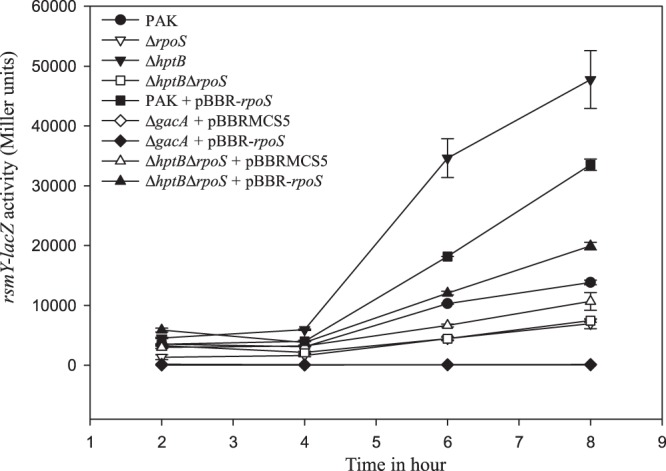
Expression of PrsmY–lacZ transcriptional fusion in various P. aeruginosa strains. Activity of the transcriptional chromosomal fusions was monitored at different growth stages in various PAK derivated strains overexpressing or not rpoS gene. The growth curves of the tested strains were similar (Fig. S4). Corresponding β-galactosidase activities are expressed in Miller units and correspond to mean values (with error bars) obtained from three independent experiments. Statistics performed on values obtained at 6 and 8 hours are presented in Fig. S3.
Finally, we confirmed that the regulation of rsmY depends on RpoS and not on FliA, the other sigma factor post-translationally regulated by the HsbR-HsbA partner switch25, since, as already shown, the absence of FliA had no effect on fusion expression (Fig. S5).
RpoS promotes biofilm formation
These first results indicate that RpoS could have a positive effect on biofilm formation in P. aeruginosa through the activation of rsmY expression. This point was confirmed by the study of an rpoS mutant that showed a decrease of 43% in biofilm thickness compared to that obtained with the PAK wild-type strain, shown with glass tube tests and confocal microscopy (Fig. 4). The rpoS mutant of P. aeruginosa PAO1 has been described to exhibit significantly increased biofilm formation in flow cell experiments8. To clarify this point, we verified that there was no lag time in biofilm biogenesis in the rpoS-deleted strain compared to the wild-type strain that could have hidden a potential hyperbiofilm phenotype (Fig. S6). We propose that the discrepancy of phenotypes reported for the rpoS mutant in the literature compared to this study can be due to genetic differences between the strains or more probably to variability in the tested conditions as it has already been shown for Escherichia coli30. In addition, complementation of the ΔrpoS mutant by a plasmid harbouring the rpoS gene (pJN-RpoS) restored biofilm biogenesis indicating a direct correlation between RpoS and biofilm formation. Furthermore, strong biofilm synthesis appeared in the wild-type strain only when it harboured and expressed the plasmid pJN-RpoS (Fig. 4A).
Figure 4.
Biofilm formation in various P. aeruginosa strains. (A) Biofilm production in glass tubes was illustrated (upper panel) and quantified after Crystal Violet-staining (lower panel). Corresponding levels of biofilm production represent mean values and standard deviations obtained from six independent experiments. Wilcoxon-Mann-Whitney tests were performed and *, **, *** and ns referred to p < 0.05, p < 0.01 and p < 0.001 and nonsignificant difference, respectively. (B) Biofilm formation was monitored by confocal laser scanning microscopy after 12 h. The extracted z images and their respective xy and xz planes are shown.
To corroborate the results obtained with the PrsmY::lacZ fusion (Fig. 3), the ability of the ΔhptBΔrpoS strain to synthesise a biofilm was tested in glass tubes. The hyperbiofilm phenotype of the ΔhptB mutant was abolished in the strain carrying the double deletion since the biofilm detected in the glass tube was 70% thinner than that of the ΔhptB strain (Fig. 4A). Moreover, the production of RpoS from pJN-RpoS in the ΔhptBΔrpoSstrain led to the resaturation of the hyperbiofilm phenotype (Fig. 4A). To further determine the morphology of the biofilm, confocal laser scanning microscopy using 4′,6′-diamidino-2-phenylindole (DAPI)-labelled cells was performed (Fig. 4B). The expression of rpoS in the PAK strain led to a modification of the morphology of the biofilm; although there were still isolated cells and it was thin, the biofilm was more compact and homogenous compared to that of the PAK strain. In agreement with the above results, the thick biofilm of the hptB strain was significantly decreased when rpoS was deleted in this strain (Fig. 4B). Interestingly, in the ΔhptBΔrpoS mutant, the overproduction of RpoS led to increased biofilm formation that was thicker than that of the PAK/pJN-RpoS strain. Altogether, these results confirm the positive role of RpoS in the regulation of biofilm synthesis, the presence of RpoS in the HptB pathway, and the hierarchy in the regulation cascade.
Although the mechanism is not understood, Valentini and co-workers have shown a connection between the HsbD diguanylate cyclase and the HptB pathway during activation of rsmY expression27 (Fig. 1A). To question a putative link between HsbD and RpoS, we tested biofilm formation of hsbD and rpoS single and double deletion mutants in a wild type and hptB context. As expected, the deletion of only one of these genes led to a decrease in biofilm formation (Fig. 5)27, while the hsbD rpoS double deletion almost abolished biofilm formation in both the PAK and hptB strains, indicating a cumulative effect of the mutations.
Figure 5.
Impact of hsbD on biofilm formation in various P. aeruginosa strains. Biofilm formation is monitored by confocal laser scanning microscopy after 12 h. The extracted z images and their respective xy and xz planes are shown.
Phosphorylation of HsbA controls the switch in P. aeruginosa lifestyle
The interaction between HsbR and HsbA occurs when HsbA is phosphorylated on Ser5625,27. Under these conditions, we hypothesised that RpoS is not bound to HsbR and thus can positively control genes of its regulon, such as rsmY, leading to biofilm formation. Otherwise, when not phosphorylated on Ser56, HsbA binds FlgM. The sigma factor FliA is freed and available to positively regulate the swimming process. It is likely, that according to environmental cues, P. aeruginosa could choose between biofilm formation and swimming and the state of the bacterium depends on the phosphorylation status of HsbA. To mimic and control the phosphorylation state of HsbA, we engineered a strain deleted for hsbA and harbouring a plasmid allowing the production of native HsbA or two HsbA variants, HsbAS56A and HsbAS56D, mimicking its non-phosphorylated or phosphorylated forms, respectively. Finally, recombinant hsbA strains were tested for their ability to synthesise a biofilm and to swim. In the absence of HsbA, bacteria formed a biofilm and swam at a level that was independent of the HptB pathway, which was considered the reference for the experiment (Fig. 6A,B). The production of wild-type HsbA in the mutant drove the cells toward a planktonic state since an increase of 40% of swimming was observed compared to the mutant. Complementation of the deleted strain by HsbAS56A led to an 80% increase in the swimming capacity of the recombinant strain whereas its ability to form a biofilm was decreased by 60%. This indicates that the unphosphorylated state of HsbA mimicked here by the Ser56Ala substitution favours the planktonic state of the bacteria, which corresponds to a release of FliA and a sequestration of RpoS (Fig. 6). Under these conditions, genes involved in swimming are activated while those involved in biofilm formation and under RpoS regulation are repressed. By contrast, when the deleted strain was complemented with HsbAS56D, biofilm formation was increased by 45% compared to the deleted strain while swimming was similar to that of the hsbA strain (Fig. 6). These results indicate that when the substitution mimics the phosphorylated state of HsbA, the bacteria are rather organised in biofilm structure rather than planktonic and swimming. Under these conditions, RpoS is released from HsbR and FliA is sequestered by FlgM (Fig. 6). Thus, it appears that the balance between phosphorylated and dephosphorylated HsbA drives biofilm formation or the swimming ability of the bacterium.
Figure 6.
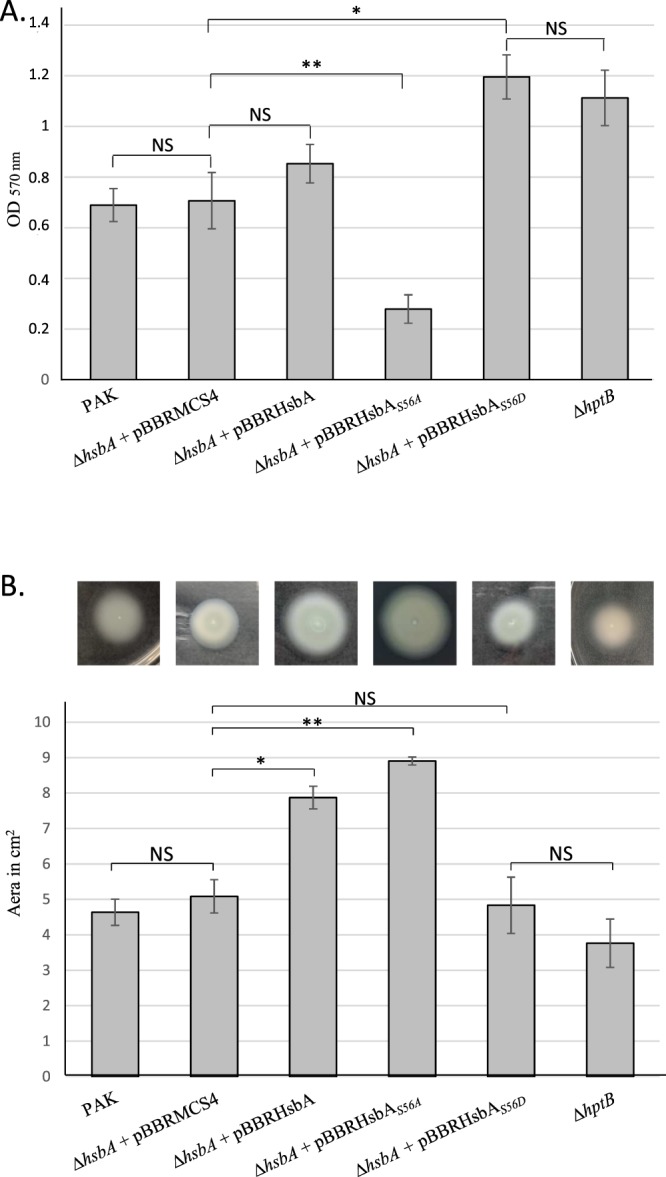
Impact of HsbA variant on biofilm formation and swimming motility. (A) Quantification of biofilm production after Crystal Violet-staining. Corresponding levels of biofilm production represent mean values and standard deviations obtained from three independent experiments. (B) Swimming mobility on soft agar plate was illustrated (upper panel) and colony size surface was measured (lower panel). Colony surface is expressed in square cm and correspond to mean values and standard deviations obtained from three independent experiments. Wilcoxon-Mann-Whitney tests were performed and *, **, *** and ns referred to p < 0.05, p < 0.01 and p < 0.001 and nonsignificant difference, respectively.
Discussion
In P. aeruginosa, approximately 700 genes are under the direct or indirect control of RpoS, and most are related to virulence and quorum sensing31. Among them, a positive regulation of the pls gene involved in the production of biofilm matrix polysaccharides production has been reported10. Therefore, it is of high importance to understand the different levels of RpoS regulation. To our knowledge, little is known about the post-translational regulation of RpoS in P. aeruginosa compared to that of E. coli, for example32,33. However, it has been shown that RpoS is degraded by ClpXP machinery during exponential growth34. In E. coli, post-translational regulation of RpoS depends on RssB, which binds the sigma factor to deliver it to the ClpXP machinery. In the presence of stress, Ira proteins are produced (IraP, IraM, IraD) and bind RssB to free RpoS, which binds RNA polymerase and activates or represses genes of its regulon35. In this study, we unveiled that in P. aeruginosa, RpoS is controlled at the post-translational level by the HsbR-HsbA partner switch. In S. oneidensis, CrsR sequesters RpoS during the exponential phase of growth and releases it when a signal arises or when the bacterium enters stationary phase. It is likely that in P. aeruginosa a similar mechanism controls the release and sequestration of RpoS, preventing its complete degradation by the Clp machinery and keeping it rapidly available. It is noteworthy that the mechanism of action of the two systems, CrsR-CrsA and HsbR-HsbA, present differences since CrsR binds CrsA when the latter is not phosphorylated whereas HsbR binds phosphorylated HsbA (Fig. 7)21,26,27. Moreover, phosphorylated HsbA recognises two partners since it has recently been shown to also bind HsbD, a diguanylate cyclase36. The binding between HsbD and phosphorylated HsbA supports biofilm biogenesis and drives localisation of the complex to the cell pole27. It would be interesting in further investigations to determine whether a complex with the three proteins exists at the pole of the cell. hsbR and hsbA expression is positively regulated by RpoS31, suggesting that the production of HsbR and HsbA is enhanced when RpoS is required during stationary phase or for biofilm biogenesis. Finally, the discovery that in P. aeruginosa, the HsbR-HsbA partner-switch regulates the sigma factor of the general stress response corroborates the notion that CrsR-CrsA homologous systems interplay in a general manner in the post-translational regulation of RpoS in various bacteria.
Figure 7.
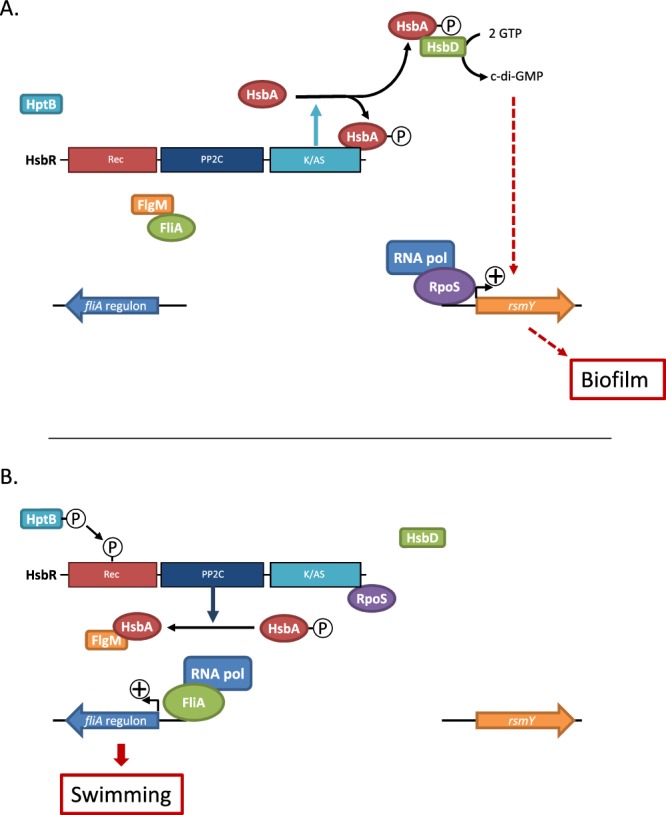
The HtpB/HsbRAD/RpoS signaling network. (A) Unphosphorylated form of HsbR triggers HsbA phosphorylation through its kinase/Anti-σ domain (D3 domain). Once phosphorylated HsbA binds HsbR kinase/Anti-σ factor domain and HsbD diguanylate cyclase, this binding trigger both the releases of RpoS σ-factor and c-di-GMP production which are biofilm-inducing. (B) Phosphorylated form of HsbR triggers HsbA dephosphorylation through its phosphatase domain. Once dephosphorylated HsbA binds FlgM anti-σ factor and release HsbR kinase/Anti-σ factor domain and HsbD. Under its none-phosphorylated form HsbA binds FlgM and triggers swimming motility thought FliA σ-factor. HsbA dephosphorylation shuts down biofilm formation by inhibiting HsbD c-di-GMP production and by sequestration of RpoS by HsbR.
The second major point of this work is that RpoS controls biofilm formation. It acts at least through the regulation of RsmY by the HptB pathway. The control of biofilm formation by RpoS through the activation of sRNAs has been reported in other bacteria. For instance, in E. coli and Salmonella, three sRNA (SdsR, GadY, and SraL) genes are part of the RpoS regulon. Expression of these non-coding RNAs triggers biofilm formation in these two organisms6. In P. aeruginosa, under our conditions, the absence of RpoS led to a decrease in biofilm thickness and the presence of more planktonic cells while its overproduction reinforced biofilm homogeneity and thickness. The epistasis experiments established that the control of RpoS by HsbR-HsbA was part of the HptB pathway and independent of the GacA pathway. We also showed that although HsbD intersects with the HptB pathway to control biofilm formation27, activation by RpoS is independent of that of HsbD.
Furthermore, we demonstrated that RpoS regulation by HsbR-HsbA is connected to regulation of the FliA sigma factor under the control of the FlgM-HsbA partner-switch. The two partner-switching systems form a network controlling the availability of two sigma factors that in turn control two cellular processes with antagonist effects. While RpoS is necessary for a community way of life, FliA drives the swimming process. The common element of these two systems is the anti-sigma factor antagonist HsbA, which is responsible for the switch between these two lifestyles. It is noteworthy that complementation of the hsbA mutant by a plasmid producing HsbA seems to favour a planktonic lifestyle, likely because under the tested experimental conditions, HsbA was produced to a greater extent than HsbR. As shown by mimicking the phosphorylated or non-phosphorylated state of HsbA, the bacterium chooses to form a biofilm or to swim, respectively. The signal transduced by the HptB pathway leads to activation of the phosphatase borne by the second domain of HsbR and thus to the dephosphrylation of HsbA, which can in turn bind FlgM and liberate FliA. Therefore, we suggest that the interconnection of the two systems drives biofilm formation and likely also its dispersal. According to environmental cues and the generated benefits, bacteria will trigger one or the other of these two modes of life. A recent study in Vibrio cholerae indicated that the signal input of biofilm dispersal combines both the individual stress response and collective information related by quorum sensing37. It is likely that this is also the case in P. aeruginosa38. This is reminiscent of the conclusions of a recent study27, which indicated that the adenylate cyclase HsbD is involved in biofilm biogenesis as well as in the various motilities of bacteria. These conclusions are in perfect agreement with our results since HsbD binds phosphorylated HsbA, and the phosphorylation state of HsbA triggers one of the two lifestyles. Moreover, it highlights once again the complexity of the process driving the switch between the various life states offered to the bacterium. The choice made appears like a jigsaw in which each piece moves the balance to one or the other side.
In conclusion, we have shown that the post-translational regulation of RpoS in P. aeruginosa depends on the HsbR-HsbA partner-switch. This system is connected to the FlgM-HsbA partner-switch and HsbA, according to its phosphorylation state, triggers the release or sequestration of RpoS and FliA. The connection of these two mechanisms with antagonist goals is likely the most efficient system the bacteria has found to decide to swim or to form and disperse a biofilm.
Materials and Methods
Bacterial strains, growth conditions, and media
The bacterial strains and plasmids used in this study are described in Table S1 and the oligonucleotides used in Table S2. Strains were grown aerobically in Luria–Bertani (LB) broth or on LB agar at 37 °C or 30 °C. Plasmids were introduced into P. aeruginosa by triparental mating using the conjugative properties of pRK2013. The transformants were selected on Pseudomonas isolation agar. Antibiotics were used at the following concentrations for E. coli: 50 µg/mL ampicillin, 50 µg/mL streptomycin, 25 µg/mL kanamycin, and 15 µg/mL tetracycline. For P. aeruginosa, 500 µg/mL carbenicillin, 2000 µg/mL streptomycin, 60 µg/mL gentamicin, and 200 µg/mL tetracycline were used.
Bacterial two-hybrid experiments
The DNA regions encoding rpoS were PCR amplified using PAK or Shewanella oneidensis MR-1 genomic DNA as templates with appropriate oligonucleotide pairs (Table S2). PCR products were digested by XbaI/KpnI of PAK RpoS or EcoRI/XhoI of SO RpoS and cloned into pKT25 or pUT18C, yielding pKT25-rpoS and pUT18C-rpoS, respectively. The adenylate cyclase-deficient E. coli strain BA159 (BTH101 clpXP::cat rpoS::tet) was used to screen for positive interactions39. BTH101 competent cells were transformed simultaneously with pKT25 and pUT18C derivatives and transformants were selected on agar plates supplemented with ampicillin (100 μg/mL) and kanamycin (50 μg/mL) after 2 days of growth at 30 °C. Cell treatment and measurement of beta-galactosidase activity were performed as previously described13.
Measurement of β-galactosidase activity
Strains carrying the lacZ transcriptional fusions were grown in LB under agitation at 37 °C in the presence of 0.5% arabinose to induce pJN105 promoter expression. Bacterial cells were collected by centrifugation at different growth times. β-galactosidase activity was measured using the method developed by Miller.
Biofilm assay
P. aeruginosa adherence assays were performed in individual glass tubes containing 1 mL of medium as described previously40. Bacteria were grown in M63 medium supplemented with 1 mM MgCl2, 0.5% casa-amino acids, and 0.2% glucose under static conditions at 30 °C. After 12 h, the cultures were incubated with 1% Crystal Violet for 10 min to stain the attached bacteria and washed twice. Staining was extracted by treatment with 400 μL of 95% ethanol and 600 μL of water. All quantification assays measured at 570 nm were performed at least in triplicate. For confocal laser scanning microscopy analysis of biofilms, P. aeruginosa strains were grown in a 4-well chambered coverglass (Lab-teK II). M63 derivate medium (200 μL) containing a bacterial suspension at OD600 of 0.1 was incubated at 30 °C. After 12 h, the medium was removed from each chamber and rinsed twice by adding 200 μL of sterile phosphate-buffered saline to remove unattached cells. Prior to observation, bacteria were fixed with 4% paraformaldehyde and stained using DAPI for 15 min. Images were taken at locations of biofilm formation using a confocal laser scanning microscope Confocal Olympus FV1000. Positions were chosen for sagittal sections (xz position) to minimise experimental variability. The number of images for three-dimensional biofilm observation within each stack depended on biofilm thickness. All confocal images were analysed using ImageJ software41.
Construction of deletion mutants
PCR was used to generate a 500 bp DNA fragment upstream (Up) and a 500 bp DNA fragment downstream (Dn) of the hsbD, rpoS and fliA genes using the appropriate pairs of primers (Table S2). Upstream and downstream PCR products were linked together by overlapping PCR and products were digested with XbaI and SpeI and cloned in the suicide vector pKNG101, yielding pKNG101ΔhsbD, pKNG101ΔrpoS and pKNG101ΔfliA, respectively. The suicide plasmids were introduced into P. aeruginosa via a three-partner procedure and the deletion mutants were obtained by double selection on PIA agar plates supplemented with streptomycin (1000 µg/mL) at 37 °C and NaCl-free LB agar containing 6% sucrose at 30 °C. The PAKΔhptBΔrpoS and PAKΔhptBΔfliA double mutants were constructed as follows: the pKNG101ΔfliA or pKNG101ΔrpoS vector was introduced by mating into the PAKΔhptB. The PAKΔhsbDΔrpoS, PAKΔhptBΔhsbD double mutants and the PAKΔhptBΔhsbDΔrpoS were constructed as follows: the pKNG101ΔhsbD vector was introduced by mating into the PAKΔhptB, PAKΔrpoS and PAKΔhptBΔrpoS.
Gene overexpression
A DNA fragment corresponding to the rpoS open reading frame was amplified by PCR using appropriate oligonucleotide pairs (Table S2) and cloned into the pBBRMCS5 vector yielding pBBR-rpoS. After DNA sequencing, pBBR-rpoS was digested using EcoRI/XbaI for subcloning into pJN105, yielding pJN-rpoS. The hsbAS56A and hsbAS56D variants were constructed using the quick exchange site-directed mutagenesis method. Briefly, the serine residue at position 56 was substituted with an alanine or glutamine residue. This was done by using the pBBR-hsbR vector as matrice and by PCR using pfu turbo DNA polymerase (Stratagene) and 39-mer primers that incorporated appropriate mismatches to introduce the expected mutations (Table S2). The resulting PCR products were digested with DpnI for 1 h and introduced into E. coli by transformation.
Swimming assays
Swimming assays were carried out on 10 g/L tryptone, 5 g/L NaCl, and 0.3% agar plates. Standardised overnight culture (0.5 μL) was deposited below the surface of the agar and plates were incubated at 30 °C overnight. Pictures were taken from a representative plate out of four independent experiments. ImageJ software was used to determine the area of the plate surface covered by the bacteria.
Significance
This work demonstrates that the choice made by P. aeruginosa between forming biofilms or swimming results from a connection between two partner-switches sharing the same anti sigma factor antagonist. We established that HsbR is an anti-sigma factor controlling RpoS and unveiled a connection between the HptB-HsbR-HsbA signal transduction cascade and the RpoS pathway during biofilm biogenesis. Another important finding focuses on the role of the anti-sigma factor antagonist HsbA in the balance between sessile and planktonic life styles. Altogether these results increase our knowledge of the mechanism driving the switch between these two ways of life, which are crucial to control P. aeruginosa in its various biotopes and clinical contexts.
Supplementary information
Acknowledgements
Authors thank members of their respective group for fruitful discussions and in particular Olivier Genest, Olivier Lemaire and Vincent Méjean. This work was supported by the Centre National de la Recherche Scientifique (CNRS) and Aix-Marseille Université. CB is supported by the French Cystic Fibrosis Foundation (VLM). SB was supported by Aix-Marseille Université.
Author Contributions
S.B., C.B. and C.I.N. designed research; M.B., S.B. and L.H. performed research; S.B., M.B., L.H., C.I.N. and C.B. analyzed data and reviewed the manuscript; and C.B. and C.I.N. wrote the paper.
Competing Interests
The authors declare no competing interests.
Footnotes
Publisher’s note: Springer Nature remains neutral with regard to jurisdictional claims in published maps and institutional affiliations.
Contributor Information
Chantal Iobbi-Nivol, Email: iobbi@imm.cnrs.fr.
Christophe Bordi, Email: bordi@imm.cnrs.fr.
Supplementary information
Supplementary information accompanies this paper at 10.1038/s41598-019-42653-5.
References
- 1.Zakaria, Z. A., Ahmad, W. A., Wan Haslinda Wan, A. & Sindhu, M. In Biofilms in Bioremediation: Current Research and Emerging Technologies (Caister Academic Press) 10.21775/9781910190296 (2016).
- 2.Barral-Fraga L, Martiñá-Prieto D, Barral MT, Morin S, Guasch H. Mutual interaction between arsenic and biofilm in a mining impacted river. Sci. Total Environ. 2018;636:985–998. doi: 10.1016/j.scitotenv.2018.04.287. [DOI] [PubMed] [Google Scholar]
- 3.Flint, steve & Wolfaardt, G. In Microbial biofilms: current research and applications / edited by Gavin Lear and Gillian Lewis. - Version details - Trove at https://trove.nla.gov.au/work/160549306?q&sort=holdings+desc&_=1533035393731&versionId=176483180 (2012).
- 4.Lebeaux D, Ghigo J-M, Beloin C. Biofilm-Related Infections: Bridging the Gap between Clinical Management and Fundamental Aspects of Recalcitrance toward Antibiotics. Microbiol. Mol. Biol. Rev. 2014;78:510–543. doi: 10.1128/MMBR.00013-14. [DOI] [PMC free article] [PubMed] [Google Scholar]
- 5.Venkatachalam Lakshmanan, A. S. K. and H. P. B. In Microbial biofilms: current research and applications/edited by Gavin Lear and Gillian Lewis 43–60 at https://www.caister.com/hsp/abstracts/biofilms/03.html (2012).
- 6.Mika F, Hengge R. Small RNAs in the control of RpoS, CsgD, and biofilm architecture of Escherichia coli. RNA Biol. 2014;11:494–507. doi: 10.4161/rna.28867. [DOI] [PMC free article] [PubMed] [Google Scholar]
- 7.Suh SJ, et al. Effect of rpoS mutation on the stress response and expression of virulence factors in Pseudomonas aeruginosa. J. Bacteriol. 1999;181:3890–7. doi: 10.1128/jb.181.13.3890-3897.1999. [DOI] [PMC free article] [PubMed] [Google Scholar]
- 8.Whiteley M, et al. Gene expression in Pseudomonas aeruginosa biofilms. Nature. 2001;413:860–864. doi: 10.1038/35101627. [DOI] [PubMed] [Google Scholar]
- 9.Kekeç Ö, Gökalsın B, Karaltı İ, Kayhan FE, Sesal NC. Effects of Chlorine Stress on Pseudomonas aeruginosa Biofilm and Analysis of Related Gene Expressions. Curr. Microbiol. 2016;73:228–35. doi: 10.1007/s00284-016-1056-2. [DOI] [PubMed] [Google Scholar]
- 10.Irie Y, et al. Pseudomonas aeruginosa biofilm matrix polysaccharide Psl is regulated transcriptionally by RpoS and post-transcriptionally by RsmA. Mol. Microbiol. 2010;78:158–72. doi: 10.1111/j.1365-2958.2010.07320.x. [DOI] [PMC free article] [PubMed] [Google Scholar]
- 11.Damron FH, et al. Analysis of the Pseudomonas aeruginosa regulon controlled by the sensor kinase KinB and sigma factor RpoN. J. Bacteriol. 2012;194:1317–30. doi: 10.1128/JB.06105-11. [DOI] [PMC free article] [PubMed] [Google Scholar]
- 12.McGuffie BA, Vallet-Gely I, Dove SL. σ Factor and Anti-σ Factor That Control Swarming Motility and Biofilm Formation in Pseudomonas aeruginosa. J. Bacteriol. 2015;198:755–65. doi: 10.1128/JB.00784-15. [DOI] [PMC free article] [PubMed] [Google Scholar]
- 13.Chambonnier G, et al. The Hybrid Histidine Kinase LadS Forms a Multicomponent Signal Transduction System with the GacS/GacA Two-Component System in Pseudomonas aeruginosa. PLOS Genet. 2016;12:e1006032. doi: 10.1371/journal.pgen.1006032. [DOI] [PMC free article] [PubMed] [Google Scholar]
- 14.Chatterjee A, et al. GacA, the response regulator of a two-component system, acts as a master regulator in Pseudomonas syringae pv. tomato DC3000 by controlling regulatory RNA, transcriptional activators, and alternate sigma factors. Mol. Plant. Microbe. Interact. 2003;16:1106–17. doi: 10.1094/MPMI.2003.16.12.1106. [DOI] [PubMed] [Google Scholar]
- 15.Brencic A, et al. The GacS/GacA signal transduction system of Pseudomonas aeruginosa acts exclusively through its control over the transcription of the RsmY and RsmZ regulatory small RNAs. Mol. Microbiol. 2009;73:434–45. doi: 10.1111/j.1365-2958.2009.06782.x. [DOI] [PMC free article] [PubMed] [Google Scholar]
- 16.Brencic A, Lory S. Determination of the regulon and identification of novel mRNA targets of Pseudomonas aeruginosa RsmA. Mol. Microbiol. 2009;72:612–32. doi: 10.1111/j.1365-2958.2009.06670.x. [DOI] [PMC free article] [PubMed] [Google Scholar]
- 17.Lapouge K, Schubert M, Allain FH-T, Haas D. Gac/Rsm signal transduction pathway of gamma-proteobacteria: from RNA recognition to regulation of social behaviour. Mol. Microbiol. 2008;67:241–53. doi: 10.1111/j.1365-2958.2007.06042.x. [DOI] [PubMed] [Google Scholar]
- 18.Jennings LK, et al. Pel is a cationic exopolysaccharide that cross-links extracellular DNA in the Pseudomonas aeruginosa biofilm matrix. Proc. Natl. Acad. Sci. USA. 2015;112:11353–11358. doi: 10.1073/pnas.1503058112. [DOI] [PMC free article] [PubMed] [Google Scholar]
- 19.Bordi C, et al. Regulatory RNAs and the HptB/RetS signalling pathways fine-tune Pseudomonas aeruginosa pathogenesis. Mol. Microbiol. 2010;76:1427–1443. doi: 10.1111/j.1365-2958.2010.07146.x. [DOI] [PMC free article] [PubMed] [Google Scholar]
- 20.Houot L, Fanni A, de Bentzmann S, Bordi C. A bacterial two-hybrid genome fragment library for deciphering regulatory networks of the opportunistic pathogen Pseudomonas aeruginosa. Microbiology. 2012;158:1964–1971. doi: 10.1099/mic.0.057059-0. [DOI] [PubMed] [Google Scholar]
- 21.Hsu J-L, Chen H-C, Peng H-L, Chang H-Y. Characterization of the histidine-containing phosphotransfer protein B-mediated multistep phosphorelay system in Pseudomonas aeruginosa PAO1. J. Biol. Chem. 2008;283:9933–44. doi: 10.1074/jbc.M708836200. [DOI] [PMC free article] [PubMed] [Google Scholar]
- 22.Kong W, et al. Hybrid sensor kinase PA1611 in Pseudomonas aeruginosa regulates transitions between acute and chronic infection through direct interaction with RetS. Mol. Microbiol. 2013;88:784–97. doi: 10.1111/mmi.12223. [DOI] [PubMed] [Google Scholar]
- 23.Petrova OE, Gupta K, Liao J, Goodwine JS, Sauer K. Divide and conquer: the P seudomonas aeruginosa two-component hybrid SagS enables biofilm formation and recalcitrance of biofilm cells to antimicrobial agents via distinct regulatory circuits. Environ. Microbiol. 2017;19:2005–2024. doi: 10.1111/1462-2920.13719. [DOI] [PMC free article] [PubMed] [Google Scholar]
- 24.Mern DS, Ha SW, Khodaverdi V, Gliese N, Gorisch H. A complex regulatory network controls aerobic ethanol oxidation in Pseudomonas aeruginosa: indication of four levels of sensor kinases and response regulators. Microbiology. 2010;156:1505–1516. doi: 10.1099/mic.0.032847-0. [DOI] [PubMed] [Google Scholar]
- 25.Bhuwan M, Lee H-J, Peng H-L, Chang H-Y. Histidine-containing phosphotransfer protein-B (HptB) regulates swarming motility through partner-switching system in Pseudomonas aeruginosa PAO1 strain. J. Biol. Chem. 2012;287:1903–14. doi: 10.1074/jbc.M111.256586. [DOI] [PMC free article] [PubMed] [Google Scholar]
- 26.Bouillet S, et al. The General Stress Response σS Is Regulated by a Partner Switch in the Gram-negative Bacterium Shewanella oneidensis. J. Biol. Chem. 2016;291:26151–26163. doi: 10.1074/jbc.M116.751933. [DOI] [PMC free article] [PubMed] [Google Scholar]
- 27.Valentini M, Laventie B-J, Moscoso J, Jenal U, Filloux A. The Diguanylate Cyclase HsbD Intersects with the HptB Regulatory Cascade to Control Pseudomonas aeruginosa Biofilm and Motility. PLOS Genet. 2016;12:e1006354. doi: 10.1371/journal.pgen.1006354. [DOI] [PMC free article] [PubMed] [Google Scholar]
- 28.Bouillet S, Arabet D, Jourlin-Castelli C, Méjean V, Iobbi-Nivol C. Regulation of σ factors by conserved partner switches controlled by divergent signalling systems. Environ. Microbiol. Rep. 2018;10:127–139. doi: 10.1111/1758-2229.12620. [DOI] [PubMed] [Google Scholar]
- 29.Bouillet S, Genest O, Méjean V, Iobbi-Nivol C. Protection of the general stress response σS factor by the CrsR regulator allows a rapid and efficient adaptation of Shewanella oneidensis. J. Biol. Chem. 2017;292:14921–14928. doi: 10.1074/jbc.M117.781443. [DOI] [PMC free article] [PubMed] [Google Scholar]
- 30.Corona-Izquierdo FP, Membrillo-Hernández J. A mutation in rpoS enhances biofilm formation in Escherichia coli during exponential phase of growth. FEMS Microbiol. Lett. 2002;211:105–10. doi: 10.1111/j.1574-6968.2002.tb11210.x. [DOI] [PubMed] [Google Scholar]
- 31.Schuster M, Hawkins AC, Harwood CS, Greenberg EP. The Pseudomonas aeruginosa RpoS regulon and its relationship to quorum sensing. Mol. Microbiol. 2004;51:973–85. doi: 10.1046/j.1365-2958.2003.03886.x. [DOI] [PubMed] [Google Scholar]
- 32.Battesti A, Majdalani N, Gottesman S. The RpoS-Mediated General Stress Response in Escherichia coli. Annu. Rev. Microbiol. 2011;65:189–213. doi: 10.1146/annurev-micro-090110-102946. [DOI] [PMC free article] [PubMed] [Google Scholar]
- 33.Potvin E, Sanschagrin F, Levesque RC. Sigma factors in Pseudomonas aeruginosa. FEMS Microbiol. Rev. 2008;32:38–55. doi: 10.1111/j.1574-6976.2007.00092.x. [DOI] [PubMed] [Google Scholar]
- 34.Bertani I, Ševo M, Kojic M, Venturi V. Role of GacA, LasI, RhlI, Ppk, PsrA, Vfr and ClpXP in the regulation of the stationary-phase sigma factor rpoS/RpoS in Pseudomonas. Arch. Microbiol. 2003;180:264–271. doi: 10.1007/s00203-003-0586-8. [DOI] [PubMed] [Google Scholar]
- 35.Battesti A, Gottesman S. Roles of adaptor proteins in regulation of bacterial proteolysis. Curr. Opin. Microbiol. 2013;16:140–7. doi: 10.1016/j.mib.2013.01.002. [DOI] [PMC free article] [PubMed] [Google Scholar]
- 36.Valentini M, Filloux A. Biofilms and Cyclic di-GMP (c-di-GMP) Signaling: Lessons from Pseudomonas aeruginosa and Other Bacteria. J. Biol. Chem. 2016;291:12547–12555. doi: 10.1074/jbc.R115.711507. [DOI] [PMC free article] [PubMed] [Google Scholar]
- 37.Singh PK, et al. Vibrio cholerae Combines Individual and Collective Sensing to Trigger Biofilm Dispersal. Curr. Biol. 2017;27:3359–3366.e7. doi: 10.1016/j.cub.2017.09.041. [DOI] [PMC free article] [PubMed] [Google Scholar]
- 38.Valentini M, Gonzalez D, Mavridou DA, Filloux A. Lifestyle transitions and adaptive pathogenesis of Pseudomonas aeruginosa. Curr. Opin. Microbiol. 2018;41:15–20. doi: 10.1016/j.mib.2017.11.006. [DOI] [PubMed] [Google Scholar]
- 39.Battesti A, Bouveret E. The bacterial two-hybrid system based on adenylate cyclase reconstitution in Escherichia coli. Methods. 2012;58:325–34. doi: 10.1016/j.ymeth.2012.07.018. [DOI] [PubMed] [Google Scholar]
- 40.de Bentzmann, S. et al. Unique Biofilm Signature, Drug Susceptibility and Decreased Virulence in Drosophila through the Pseudomonas aeruginosa Two-Component System PprAB. PLoS Pathog. 8 (2012). [DOI] [PMC free article] [PubMed]
- 41.Schneider CA, Rasband WS, Eliceiri KW. NIH Image to ImageJ: 25 years of image analysis. Nat. Methods. 2012;9:671–5. doi: 10.1038/nmeth.2089. [DOI] [PMC free article] [PubMed] [Google Scholar]
Associated Data
This section collects any data citations, data availability statements, or supplementary materials included in this article.



